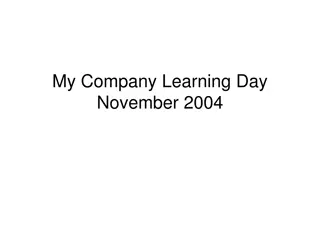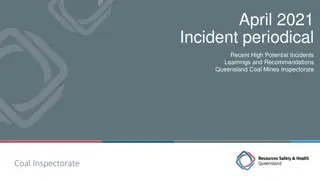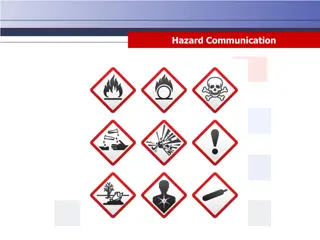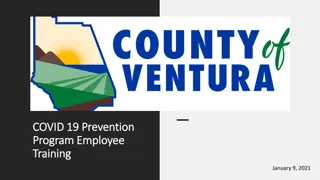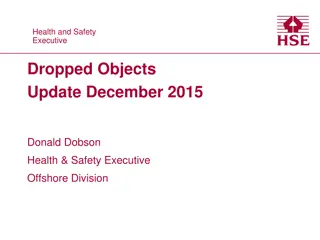Understanding Near Miss Incidents in Workplace Safety Training
Near misses are unplanned events with the potential for harm that did not result in injury or damage. This training covers the definition of near misses, reporting management, incident types, and reasons for reporting. It emphasizes the importance of addressing system weaknesses to prevent future accidents. The content also discusses Heinrich's Incident Ratio Model and the role of human error in near miss incidents.
Download Presentation

Please find below an Image/Link to download the presentation.
The content on the website is provided AS IS for your information and personal use only. It may not be sold, licensed, or shared on other websites without obtaining consent from the author. Download presentation by click this link. If you encounter any issues during the download, it is possible that the publisher has removed the file from their server.
E N D
Presentation Transcript
NEAR MISS Bureau of Workers Compensation PA Training for Health & Safety (PATHS) PPT-041-01 1
Topics Definition of a Near Miss Conditions/Incidents Reporting Management Stages Management System Report Forms PPT-041-01 2
Definition A near miss is an unplanned event that did not result in injury, illness, or damage - but had the potential to do so. Sometimes called a near hit or close call signals a system weakness that, if not corrected, could lead to significant consequences in the future. PPT-041-01 3
Another Near Miss Definition Opportunity to improve safety practice based on condition or incident with potential for more serious consequence. In this definition incident or condition is anything that a witness views worthy to address to eliminate potential to cause harm. PPT-041-01 4
Using Condition/Incident Wide variety of occurrences can be near misses: Unsafe conditions Unsafe behavior Minor incidents/injuries with potential to be more serious Events where injury could have occurred but didn t Events with property damage Events where safety barriers crossed Events with potential environmental damage PPT-041-01 5
What Happens Human error is commonly an initiating event. However, a faulty process or system allows or compounds the situation, and should be the focus of improvement. PPT-041-01 6
Incident Ratio Model Heinrich s Theory Serious Injury or Death 1 1 Most Incident Investigations Conducted 29 Biggest percentage of injury causing potential! Minor Injury Few Investigations Conducted 300 Near Miss 3,000 Unsafe Acts, Behaviors or Conditions PPT-041-01 7
Reasons for Reporting Reporting a near miss helps to establish and continue safe practices within the workplace. Information provided enables an employer to communicate facts, causes, and corrective actions to all employees regarding near misses. Provides valuable information to employees about how to avoid/prevent future accidents and injuries. Provides opportunity to improve safety, health, environmental, and security of operation. PPT-041-01 8
Reasons for Reporting Reduces tolerance for risk. Avoids complacency. Tool to identify workplace hazards. Allows employee involvement in safety program. Demonstrates Management s commitment to safety. Allows identification of possible trends. PPT-041-01 9
Near Miss Management Stages Identification Disclosure Distribution Root-Cause Analysis Solution Identification Dissemination Resolution Almost! PPT-041-01 10
Identification First stage of process. Sometimes issue not obvious. May not be recognized as near miss. Need consistency in definition and perception. When in doubt, consider as near miss. PPT-041-01 11
Disclosure Employees need to feel comfortable reporting near misses. Employees should not fear disciplinary action or peer pressure by reporting. Organization s safety culture is such that reporting a near miss is important and necessary. PPT-041-01 12
Distribution Information transferred from individual reporting to those who will make decisions regarding preventative actions. Rapid distribution of near miss information is foremost. Quick distribution helps ensure fast resolution which reduces likelihood of potential accident occurring. Follow up should occur quickly. PPT-041-01 13
Direct & Root-Cause Analysis Analyzing an incident, it is necessary to: o Assess the direct and underlying root causes that contributed to an incident. o Determine corrective actions or solutions to rectify the root cause so that recurrence is less likely. Root-cause analysis techniques can be used during near miss investigations. PPT-041-01 14
Direct & Root-Cause Analysis Depending on potential severity/complexity of near miss, cause determination can occur informally between reporting individual and direct supervisor. Or may require formation of an investigation team for a thorough analysis with resulting recommendations. PPT-041-01 15
Solution Identification For each cause, corrective actions need to be determined. Ideally, corrective actions should eliminate potential for recurrence but may not always be feasible. Desirable that solutions reduce likelihood of recurrence or at least reduce potential impact in case of recurrence. All solutions should be scrutinized to assess whether there are other detracting factors (e.g. expense, employee acceptance, etc.) PPT-041-01 16
Dissemination to Implementers Corrective actions should be sent to all persons who can benefit from information. Should include individuals implementing corrective actions at location where near miss occurred. May also be appropriate to provide information regarding near miss to larger audience. Avenues to support information dissemination should be developed and utilized. PPT-041-01 17
Resolution Not only important to resolve near miss to ensure potential accidents do not occur, also essential to success of near miss program. If employees don t think near misses are acted upon they will not report in the future. Resolutions should be promoted and tracked. PPT-041-01 18
Near Miss Management System Three key components of a near miss management system: 1. Management Process 2. Tools to manage the system 3. Employee Training PPT-041-01 19
System Management Develop Near Miss Management Team: -To design company Near Miss system - To provide training for employees and management - To monitor system performance Develop Near Miss Management Oversight Team: -To provide high level guidance - To monitor Near Miss Management Team s performance PPT-041-01 20
Tools for System Management Electronic tracking system suggested: Develop graphs, charts, etc. Access information easily Information stored in one location Provide customized reporting Data collection PPT-041-01 21
Tools for System Management Develop an audit system: o Quality control process to ensure system functioning properly o Provides avenue for continuous improvement of system PPT-041-01 22
Employee Training - Topics What is a near miss and how to identify. Why near misses are important. Role in reporting near miss. Near Miss Management Team members. Near miss reporting process. How to report a near miss. How to get help with near miss/safety issues. PPT-041-01 23
Near Miss Reporting Forms Examples PPT-041-01 24
Reporting Form Development Many examples through insurance companies, colleges, websites. Make it company/site specific. Basic information: date, location, time of observation. Other pertinent information: description of situation, possible solutions, etc. Decide if you will accept anonymous reporting. Provide instructions for where completed forms are sent/dropped off. PPT-041-01 25
Summary Near Miss identification and reporting is an integral part of any good safety program. A Near Miss reporting and tracking system should be developed and implemented. Employees should be encouraged to report near misses without fear of discipline or loss of job. Reporting and tracking near misses can provide valuable information as to where weaknesses in the safety program exist. PPT-041-01 26
Contact Information Health & Safety Training Specialists 1171 South Cameron Street, Room 324 Harrisburg, PA 17104-2501 (717) 772-1635 RA-LI-BWC-PATHS@pa.gov Like us on Facebook! - https://www.facebook.com/BWCPATHS PPT-041-01 27
Questions PPT-041-01 28






